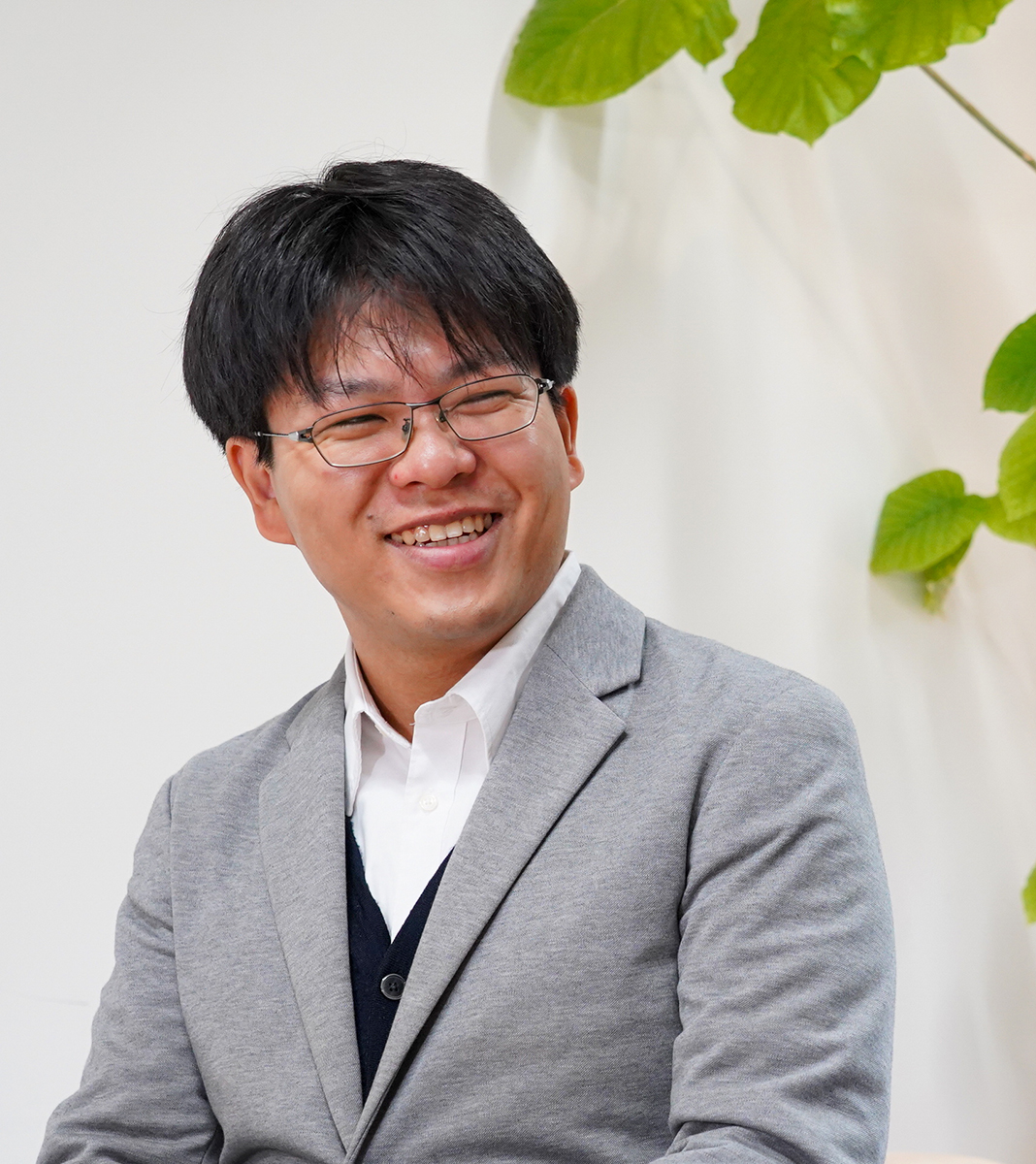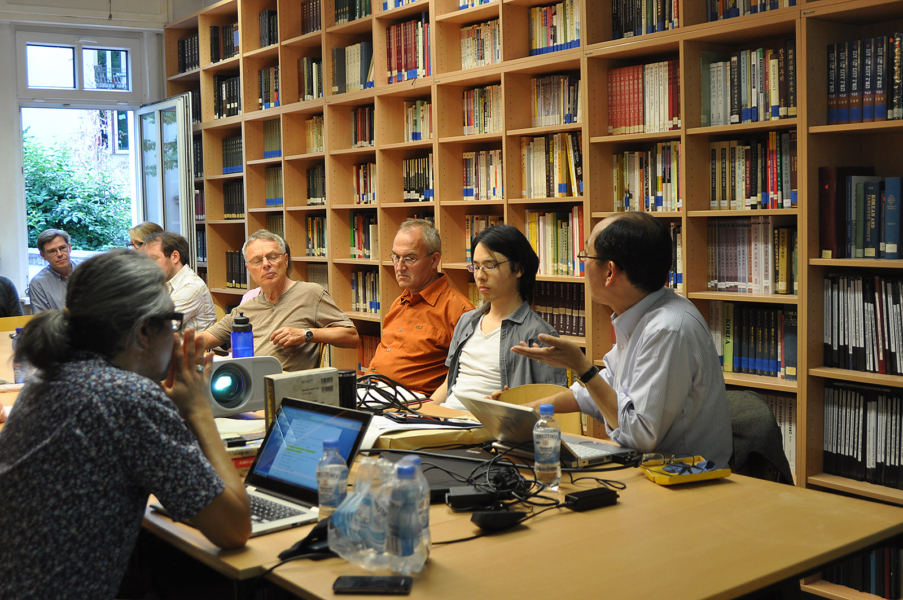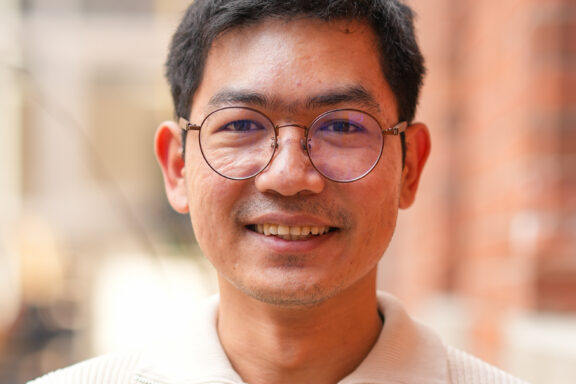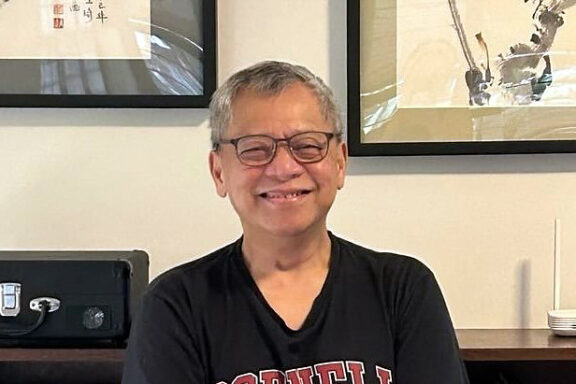
Interview with Professor Toshihiko Kishi
Biography: After completing the Graduate School of Letters at Hiroshima University with full credit, Professor Kishi worked at the Faculty of Policy Studies at the University of Shimane and the Faculty of Business Administration at Kanagawa University before assuming his current position at Kyoto University in 2010. He initially served as a professor at the Center for Integrated Area Studies (ILCAA) and is now a professor at the Center for Southeast Asian Studies. Additionally, he is a visiting professor at the University of Tokyo’s Interfaculty Initiative in Information Studies, an affiliate member of the Science Council of Japan, a visiting researcher at Toyo Bunko, and a member of the editorial advisory board of 만주연구 (Manchurian Studies). From 2020 to 2023, he was a senior program officer at the JSPS Research Center for Science System. His research encompasses a diverse array of fields, including Asian history, East Asian area studies, and representation and media studies. He has published numerous outcomes of both domestic and international collaborative research, as detailed in the main text of this interview.
Interviewer: Taihei Kikuchi (CSEAS Research Fellow)
From Visual Media Research to International Collaborations
──Professor Kishi, you have been involved in several joint research projects both in Japan and internationally, particularly in visual media studies. Can you elaborate on the background of these projects, your motivation for them, and their interconnections?
It has been 15 years since I moved to Kyoto University. During this time, I have encountered a wide variety of individuals and historical materials, which has broadened the scope and methodology of my research. Before my transfer to Kyoto University, I was particularly interested in urban history and radio media studies. After my transfer, I participated in a project at the ILCAA and initiated research focusing on the construction of web databases and their relationship with linked visual media. My first publication was Visual Empire in Manchukuo (Yoshikawa Kobunkan). Subsequently, my focus has shifted towards publishing results based on collaborative scientific research with national and international institutions. These include Visual Taiwan: Selected News Photos of The Asahi Shimbun Company (視覺臺灣:日本朝日新聞社報導影像選輯) with the Institute of Taiwan History at Academia Sinica and Images of Macau: East-West Exchange and the Derwent Collection (Benseisha Publishing, Inc.) with Hong Kong Baptist University. Furthermore, I collaborated with the Library and Archives of the Hoover Institution at Stanford University on a joint volume titledFanning the Flames: Propaganda in Modern Japan. Domestically, I worked with researchers in Japan to publish Enlightening through TV: USCAR Public Diplomacy, 1950–1972 (Fuji-Shuppan) and The Collection of North China Transport Company’s Photographic Materials (Kokushokankokai, Inc.) from the Institute for Research in Humanities at Kyoto University. Notably, this visual media research often garners attention from overseas.
Research exchanges with the Manchurian Studies Association (Korea) have also progressed. This initiative was originally sparked by a joint review of our co-edited Dictionary of Manchurian History in the 20th Century (Yoshikawa Kobunkan), which was held in South Korea. Since then, I have engaged with the association and currently serve on its editorial advisory committee. The Journal of Manchuria Studies (만주연구) features my articles on border issues in Northeast China based on the Asahi Shimbun Fuji Warehouse materials and military animals represented in photographs and memorials.
The studies of visual media led me to two primary types of research: one focusing on public relations and propaganda utilizing various media, and the other on the history of technology and communication regarding media transmission. An example of the former is my article “The Legacy of the Film Publicist Aoyama Tadakazu” in Shigaku Kenkyu (Journal of Historical Studies, Hiroshima), which analyzes valuable materials held by the Harvard-Yenching Library. The article contributed to the book Propaganda in Imperial Japan (Chuokoron-Shinsha), which summarizes the evolution of diverse media used for political propaganda. Upon receiving a favorable reception in Japan, a Korean edition was published, titled 제국 일본의 프로파간다. In a related vein, my interest in the inter-regional connections of audiovisual media led to the publication of my findings on SP recordings under the title The East Asian Popular Song Hour (Iwanami Shoten). As for my research on the history of technology, it culminated in publications such as The Information, Communication, and Media History as part of the Yamakawa History Lecture Series, The Post-War History of Japan-China Submarine Cables (Yoshikawa Kobunkan), and articles including “The Formation of Broadband Telecommunications Networks in East Asia in the 1970s” in Reorganization of Socio-Economic Systems in Modern and Contemporary China, edited by Professor Mamoru Murakami of the Institute for Research in Humanities at Kyoto University, as well as “The Image Power in the 1940s” in Documentary Reconstruction of 20th Century Chinese History, edited by Sadahiro Ishikawa.
At the core of my research into various media lies a fundamental question: How do the production, distribution, and reception of transnational media evolve over time and by region? I also investigate imperial history, prisoner-of-war issues, and immigration history. My long-standing interest in concessions and foreigners in China led me to missionary documents in the Yale University collection, where I learned about various prisoners of war, including Japanese and other foreign non-combatants in mainland China during the war. This exploration culminated in the publication of The Asiatic Pacific War and POW Camps (Kokusai-shoin). I utilized the same documents to investigate German POWs in wartime China, resulting in a chapter in Ostasien im Blick (OSTASIEN Verlag), a commemorative volume on East Asia from the Institute of Orient and Asian Studies at Bonn University. Additionally, my examination of Japanese immigration in the 1930s was published in the collection Japanese America on the Eve of the Pacific War by Hoover Institution Press.
When Dreams Meet Reality: Heeding Advice and Remaining Curious
──You have been actively engaged in an extensive range of research. What were your interests in high school and university? What influences shaped your path in graduate school?

Until my sophomore year in high school, I aspired to pursue engineering. My childhood dream was to study robot mechanics at university. However, I had to relinquish that dream due to health issues that necessitated long-term hospitalization, preventing me from keeping pace with my physics classes.
As soon as I began studying the Mongolian language at university, I found it intriguing and became engrossed. Nevertheless, when I had to abandon my dream of studying abroad for health reasons, my passion for the language diminished. By the time I graduated, I felt isolated and was uncertain about my future career. Should I become a museum curator, an academic researcher, or pursue another path? At that juncture, I sought advice from a former junior high school teacher who worked at the Kitami Institute of Technology. He advised me, “Kishi-kun, your vocation is research.” This pivotal moment provided direction in my life. While I was somewhat naive, I now recognize the importance of trusting the guidance of those who have paved the way before us.

In graduate school, based on my supervisor’s advice, I shifted from my initial interest in modern Mongolian history to focus on the political history of the late Qing dynasty. I accepted this shift with a degree of openness, particularly since I was already diligently studying Chinese. I am grateful for those senior students and colleagues specializing in modern Chinese history during my graduate studies, as such research peers play a crucial role in our development. I cannot overstate how encouraged I was by my contemporaries around the world during my early working days. I once believed that research was an individual endeavor, yet I found that the collaborative spirit of both domestic and international colleagues positively stimulated my own work.
──Please tell us about any episodes of people or places that have left a lasting impression on you since you began your research career.
From the outset, my research has centered on East Asia, yet I have been drawn to environments that differ from this worldview. My postgraduate supervisor, a researcher at Harvard University during the early post-war period, often emphasized the importance of examining Western societies to truly understand Asia. These insights motivated me from a young age to continuously investigate materials from non-Asian countries, sometimes at my own expense and with my family in tow. Perhaps as a result of these efforts, I have had the privilege of conducting joint research with institutions such as the Harvard-Yenching Library, the Library and Archives of the Hoover Institution at Stanford University, and the Institute of Orient and Asian Studies at Bonn University. Despite my limited proficiency in English, I have pursued ambitious endeavors.
The landscapes and environments of Western campuses fascinate me—the expansive grounds, the richness of nature, the presence of international students and researchers, and the diversity of materials and books. I have often pondered the significance of studying Asia from these vantage points. Over time, I have come to realize that an interest in Asian studies is not merely an intellectual pursuit; it is intricately linked to the identity of the researchers themselves.
──Can you share any particular influences or books that have significantly impacted you?
Several books have influenced me both directly and indirectly. One such work is Visual Culture: An Introduction by John A. Walker and Sarah Chaplin (Manchester University Press, 1997), which I read when I began my exploration of visual media studies. This book elucidates the concept of visual culture and highlights the significance of examining it through the lens of cultural studies. While I do not fully endorse the research methodologies associated with Cultural Studies, I have gained insights into the politics, institutions, and technological considerations surrounding art. For me, this theoretical framework has its limitations, prompting me to revisit the book occasionally. Nevertheless, as it is an older text, I recognize that both research trends and my own interests have evolved significantly since I first engaged with it.
Keys to Curiosity and Persistence
──What are some of the difficulties and innovations you have encountered in compiling the results of your research into a paper or book?
I believe that Japanese researchers could benefit from enhanced planning skills. While it is crucial to investigate research trends in detail, there are times when it is necessary to envision ideas that take bold leaps forward. Realizing these ideas often requires the support of diverse colleagues. The research community is composed of individuals with unique perspectives, quick wit, advanced conceptualization and application skills, unconventional ideas, and original analytical capabilities. Engaging with such individuals is vital for bringing new ideas to fruition.
However, equally important is the ability to encounter materials and data that can substantiate our ideas. To facilitate these encounters, securing research funding is essential; without it, forming a research team and creating opportunities for collaboration become challenging.
In planning and executing a project, it is vital to possess the determination to persevere, to maintain a sense of enjoyment, and, above all, to respect fellow researchers. Unlike previous generations, the current research environment offers considerable convenience and efficiency, allowing us to utilize computers, networks, web databases, and archives effectively. Moreover, we have the ability to conduct research internationally with relative ease. These changes have led to the emergence of numerous outstanding young researchers. However, it has become increasingly difficult for senior researchers to present new and original findings while navigating the accomplishments of their younger counterparts. I believe that the senior generation must continue to strive for innovation and relevance in this evolving landscape.
──When do you find it interesting or difficult to continue your research?
In my case, the intrigue of my research lies in the search for materials and the discoveries I make during fieldwork. When I encounter valuable materials in archives that have previously gone unnoticed, I experience a profound thrill. Additionally, field research often presents me with facts that challenge the information I find in documents, making this process one of the most rewarding aspects of being a researcher.
Conversely, the most challenging part of my work arises when I grapple with the complexity of a region. No region is straightforward: complexity extends beyond institutions and structures to encompass the attitudes and values of the local population. As a researcher, it is crucial to engage deeply with a specific region or historical period. Yet, even after completing a paper or publishing a book, I am frequently struck by how much remains unexplained. This persistent lack of a sense of achievement can be disheartening, as I am increasingly aware of the limits of what one researcher can accomplish within a lifetime.
──You have highlighted a significant challenge in area studies: the tendency to emphasize regional peculiarities and cultural specificities. In your Kinmen Island study, you noted that “Area studies are fundamentally comprehensive and should not merely focus on analyzing the current situation.” You emphasize the necessity of transcending the limitations of regional studies that are confined to specific areas defined post-war and the importance of overcoming this limitation.
The first thing is to find an international community where you can interact with researchers with different specializations. Local information, large or small, is very diverse and complex. You need to create a personal network that goes beyond the specific discipline you have mastered.
Secondly, I recommend doing fieldwork and field observations outside your area of expertise. When I recently joined two colleagues on a research trip to Peru, I realized how useful it is to have an expert escort and commentary. Upon my return, I began to think about how I might perceive the region. I was thus able to complete my thesis on pre-war and post-war Peruvian overseas Chinese by clarifying how the present situation and events that I saw with my own eyes have changed and evolved over time. This experience has again shown me how important it is to understand the connections between regions, to think historically and comparatively.
──What is your idea of an ideal researcher?
The researcher I respect the most is Dr Yoshinobu Shiba, who is currently the Executive Librarian of Toyo Bunko. Although we do not have a direct master-disciple relationship, I sometimes have the opportunity to work under his guidance. Although he is an outstanding researcher on the history of pre-modern China, focusing on the Song dynasty, he has a broad view of the whole of Asia today and its future. His curiosity about a wide range of sources, his deep insight, and his original methods of analysis make him one of Japan’s leading historians. Furthermore, Dr. Shiba’s personality and humility are something that we, as researchers of the future, have much to learn from. We are truly lucky to have such a predecessor in this era.
Recommendation for Young People and the Future of Research
──Can you comment on a book that you would recommend to young people?
When it comes to recommending a specific book, I find it quite challenging. However, I would encourage young scholars to explore encyclopedias and dictionaries published by Yoshikawa Kobunkan. Notable titles include the Asia Pacific War Dictionary, Postwar Okinawa Life History Dictionary,Japan Media History Chronological Table, Dictionary: Pacific War and Children,Foreign Relations History Dictionary, and our edited Manchurian History Dictionary of the 20th Century. By browsing these references, one can gain insights not only into research trends and sources, but also into the pressing issues of the time. I believe that the best way to familiarize yourself with research trends is to consult encyclopedias directly, rather than relying solely on analyses compiled by others.
──What would you like to say to people who want to become researchers in the future?
To those aspiring to become researchers, I would emphasize the importance of a multidisciplinary approach while maintaining a focus on your specialization. As a historian, I have often faced challenges securing positions specifically aligned with my field. Therefore, having a broad range of disciplinary knowledge and interests is invaluable. As evidenced by recent changes in high school curricula, a foundation in informatics and its applications is now essential. Additionally, an understanding of environmental studies is increasingly important. I encourage you to be open to methodologies from both the humanities and the sciences. Fields such as economics, psychology, archaeology, and geography are already embracing this interdisciplinary approach. I believe it is crucial for the future of research.
──What are your ambitions for the future?
I am currently engaged in research on post-war Japan under the British Commonwealth Occupation Forces (BCOF). This work was inspired by Professor Masakazu Tanaka’s notion that the occupation of Japan served as a “contact zone” for various cultures. I aim to explore the implications of the “post-war” period, which extends into the present, alongside my ongoing studies of the pre-war and wartime contexts. I believe that this research contributes to international comparative studies and look forward to its future developments. My findings on the BCOF of the Chūgoku region in Japan are set to be published in May 2025 as part of the Okayama Bunko series by Nihon Bunkyo Shuppan.
In addition, I am collaborating with the Mainichi Shimbun and Professor Hidenori Watanabe’s laboratory at the University of Tokyo on the Mainichi Shimbun War Photo Archive Project, commemorating the 80th anniversary of the end of World War II. This initiative includes creating a digital archive of the Mainichi Shimbun’s wartime photographs and publishing a series of articles entitled Reading Wartime Photographs in the Tokyo edition of the Mainichi Shimbun. We also plan to hold an exhibition featuring these photographs next year at News Park in Yokohama. As the generation that lived through the war diminishes, it is imperative to consider how we will preserve and convey memories and records of war and disaster—a pressing challenge of our time.
Moreover, I hope to commit to promoting education that not only advances academic research, but also empowers women to actively engage in society. Even 80 years after World War II, opportunities for women to play meaningful roles in various sectors remain insufficient. This issue is particularly critical in the humanities and social sciences, as well as in science, engineering, and medicine. I hope to dedicate my remaining time as a university professor to advancing women’s education and fostering the next generation of female leaders.
──Professor Kishi, I am very impressed with how you have energetically conducted research across a variety of fields, starting from visual media studies. Your career embodies the essence of interdisciplinary research: to integrate the findings of different fields and to reappraise the region from new perspectives while continuously referencing both the documents and the field. To realize such achievement, one must build a broad network of research colleagues and actively engage in international joint research, which I believe is extremely important for the future of area studies. Thank you very much for this valuable talk.

(20 September 2024)
This article is also available in Japanese. >>
「資料を求めて世界を歩む:地域研究の未来に向けた共同研究」
貴志俊彦教授インタビュー


















